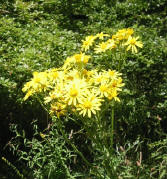

Yellow Peril – beware the Killer Weed
Everyone who cares about our environment and countryside will recognise the plant Common Ragwort (Senecio Jacobaea). It is an obvious weed in July and August when it grows up to 3 feet tall with ragged edged leaves and a yellow flower, but it is NOW that we need to act to eradicate this poisonous plant.
Ragwort also damages our environment by smothering rare wild flowers and most worrying is that research now proves that the pyrrolizidine alkaloids (the poisons in ragwort) have been found in eggs, grain, milk and honey.
Some useful information about Ragwort
If you want to safeguard the environment for future generations this is how you can help
During July and August the British Horse Society clearance volunteers will be working throughout Oxfordshire clearing ragwort from public land, commons etc. So if you can spare a few hours to help please contact me. Lets make our county a safer place for both animals and humans free from the dangers of ragwort.
If you would like further
information, leaflets or even a field visit to help identify ragwort please
contact me the BHS welfare officer : -
Miss D M Harris on 01993 702844.
Links BHS website www.bhs.org.uk follow links for ragwort